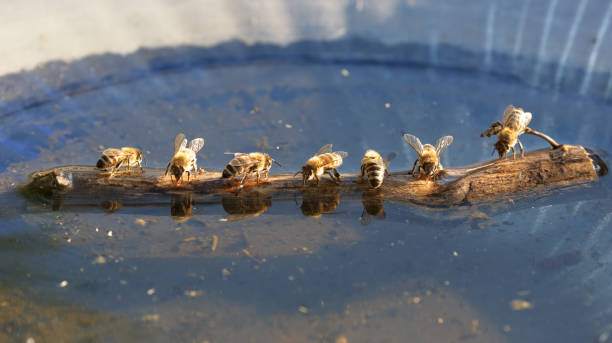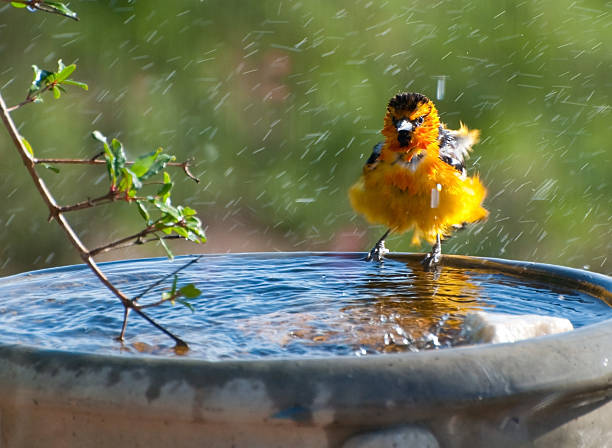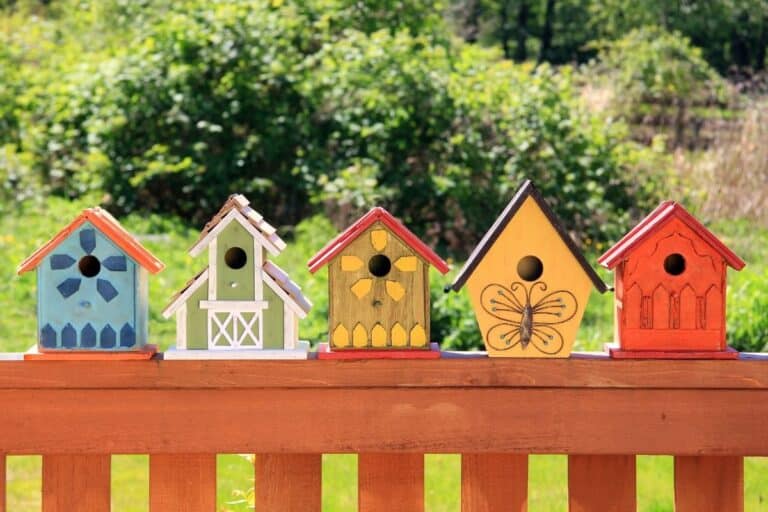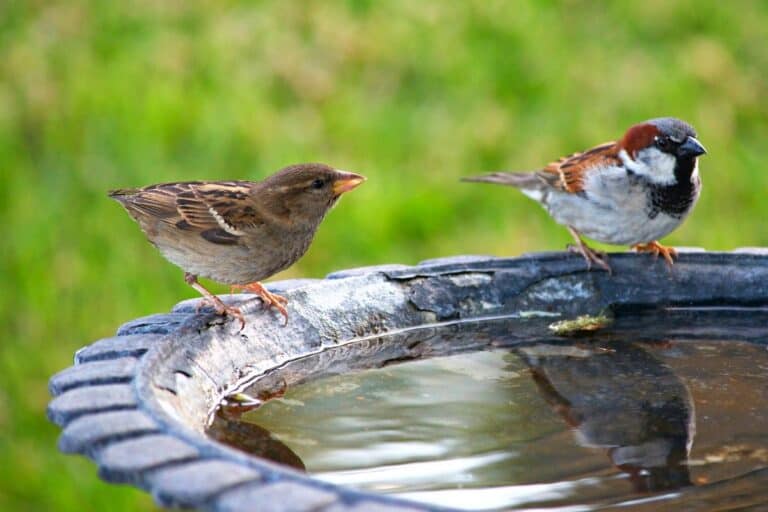Best Location for Bird Bath (10 Things You MUST Know!)
We’re reader-supported; we may earn a commission from links in this article.
Bird enthusiasts rejoice in the delightful chatter of our winged companions.
Inviting them into our outdoor sanctuaries enriches our lives.
A crucial aspect of this avian hospitality is placing bird baths thoughtfully!
In this article, we will cover the best location for a bird bath, bird behavior around water, and other related topics to setting up a bird bath.
Let’s get into it!
1. Understanding Bird Behavior Around Water

Avian behavior around water is a spectacle of instinct and necessity.
Birds, whether sparrows or robins, are inherently drawn to water. It’s a place of hydration, bathing, and a vital component of their existence.
Water is life, and for birds, it’s a lifeline.
Beyond quenching their thirst, water offers a place for birds to preen their feathers, essential for their flight and insulation.
Observing them in their interactions with water is akin to witnessing a dance—a harmonious blend of survival instincts and joyful abandon.
2. Factors Influencing Bird Bath Placement
The positioning of your bird bath goes beyond aesthetics; it plays a crucial role in determining bird visitation frequency and comfort.
The best bird baths can go wasted if it’s not placed at the right places within your backyard.
Understanding the factors that influence bird bath placement is key to creating an inviting avian oasis!
a. Sunlight and Shade: Finding the Perfect Balance
Birds enjoy a refreshing dip in the morning sun, but they prefer to avoid scorching heat. Achieving the right balance of sunlight and shade in your chosen spot is essential.
b. Wind and Open Spaces: Ensuring Safety and Comfort
Birds seek a calm and peaceful environment for their daily activities, including bathing. Position the bird bath in a sheltered spot, shielded from strong winds, to create a tranquil oasis for our feathered friends.
c. Noise Levels: Creating a Serene Atmosphere
Birds thrive in a serene ambiance. Place the bird bath away from noisy areas, such as loud machinery or bustling foot traffic, to allow them to enjoy moments of rest undisturbed.
3. Proximity to Foliage and Shelter

An attractive location can also draw birds to a bird bath.
Positioning the bath near a tree or bush can offer them protection and quick access to perching spots, allowing them to escape from potential predators.
Placing your birdbath at an appropriate distance from surrounding foliage helps create an inviting oasis that birds will enjoy visiting more often.
a. The Cozy Allure of Nearby Trees and Bushes
Birds are naturally inclined towards safety. A bird bath nestled close to trees and bushes gives them a sense of security, encouraging frequent visits.
Birds are cautious creatures, constantly vigilant for any signs of danger. Placing the bird bath near trees and bushes offers a sense of security. It’s akin to a cozy hideaway where they can drink and bathe without worry.
b. Balancing Exposure and Cover
While birds appreciate cover, they also enjoy a good view. Balancing the proximity to foliage with an open view enhances their comfort without compromising safety.
Finding the sweet spot between exposure and cover is an art. Birds like to keep an eye out for potential threats while having the comfort of nearby cover. Striking this balance ensures they feel safe yet engaged.
4. Predators and Bird Bath Placement

The presence of potential predators should be taken into consideration while placing a bird bath. Don’t place the bath too close to trees and shrubs where cats, snakes or other unwanted wild visitors could hide.
a. Mitigating Risks: Keeping Predators at Bay
Placing the bird bath at a safe height, away from potential hiding spots for predators, is a savvy move. It’s about providing refreshment without exposing our feathered visitors to unnecessary risks.
Nature, with all its beauty, has its predators. Placing the bird bath at a safe height and away from hiding spots ensures that our avian guests can indulge in a worry-free bath. Safety is paramount for their well-being.
b. Choosing Safe Heights and Locations
Optimal bird bath height matters. Elevating it to a level that’s accessible to birds yet inconvenient for predators strikes a crucial balance.
Finding the right height for the bird bath is like setting the dinner table—it needs to be just right. A height that allows easy access for birds but poses a challenge for potential predators is the key to ensuring the safety of our avian friends.
5. Accessibility and Visibility for Birds

The ideal location of the bird bath should be in an area that offers visibility and accessibility to birds. Placing it near trees or bushes that regularly shed their leaves can help it blend into its surroundings, providing a sense of safety for our avian visitors.
a. Ensuring Easy Access for our Avian Friends
Birds appreciate a friendly setup. A shallow bird bath with gradual slopes allows easy access for birds of all sizes, ensuring a seamless bathing experience.
Imagine stepping into a spa with complicated entry points—it wouldn’t be as inviting. Similarly, ensuring easy access to the bird bath with a shallow slope is like rolling out the welcome mat for our feathered friends.
b. Bird Baths as Garden Ornaments: Balancing Aesthetics and Utility
The bird bath is not just functional; it’s an aesthetic addition to the garden. Striking a balance between its ornamental appeal and functionality is an art.
Incorporating a bird bath into the garden is like adding the final brushstroke to a masterpiece. It needs to be functional, yet it should seamlessly blend into the aesthetics of the garden. It’s about merging utility with beauty.
6. Water Source and Plumbing Considerations
The water source and plumbing requirements for bird baths can vary depending on the type of bath. For instance, a pedestal bird bath requires more sophisticated plumbing than any other type.
a. Options for Water Supply: Bird Baths and Plumbing
Choosing between traditional water filling or a plumbed-in system depends on convenience, the size of your avian audience, and the practicality of your setup.
In the realm of bird baths, there are choices akin to deciding between a classic car and a modern marvel. Traditional water filling offers simplicity, while a plumbed-in system brings convenience. It’s about choosing the option that best suits your avian oasis.
b. Cleaning and Maintaining the Water Supply
Regularly cleaning and maintaining the water supply is essential. Birds deserve a fresh and clean oasis for their daily activities.
A clean bird bath is like a sparkling pool at a luxurious resort—it beckons and rejuvenates. Regular cleaning and maintenance are not just chores; they are essential acts of care for our feathered guests.
7. Landscaping and Bird Bath Placement
Placing a bird bath in the garden is an art form, with plenty of tips and tricks to help you make it attractive to birds.
a. Blending In: Making the Bird Bath a Part of Nature
Landscaping around the bird bath is an art. Incorporating natural elements seamlessly makes the bird bath a part of the landscape, attracting birds effortlessly.
Picture the bird bath as the crown jewel in a royal garden. To make it truly shine, the surrounding landscape needs to be carefully orchestrated. It’s about ensuring the bird bath doesn’t stand alone but is a seamless part of nature’s grand design.
b. Incorporating Plants for a Bird-Friendly Environment
Selecting bird-friendly plants around the bird bath not only enhances its appeal but also attracts birds, making it a thriving hub of avian activity.
Plants are like the supporting cast in a play—they enhance the lead’s performance. Similarly, choosing the right plants around the bird bath not only enhances its aesthetic but also lures more birds. It’s about creating a habitat that beckons.
8. Seasonal Considerations and Adaptability
The best place to put a bird bath is usually in an attractive location that gets direct sunlight for most of the day, but seasonal considerations can require adjustments.
a. Adapting to Changing Seasons: Winter vs. Summer Placement
Bird baths need to adapt to seasonal shifts. In warmer seasons, a shaded spot is ideal, while in winter, a sunny location prevents freezing.
Bird baths, like the seasons, change. Adapting the bird bath to suit the prevailing season ensures a steady flow of avian visitors. It’s about changing the stage to suit the performance.
b. Portable Bird Baths: Flexibility for All Seasons
For the utmost flexibility, consider a portable bird bath. You can move it around to accommodate seasonal changes, ensuring your avian guests are always comfortable.
A portable bird bath is like having a versatile tool in your gardening arsenal. It allows you to adapt to the changing seasons, ensuring your avian guests have a delightful watering hole year-round. It’s about providing comfort no matter the weather.
9. Practical Tips for Placing Your Bird Bath
When placing your bird bath, consider the following:
- Position it near cover: trees, shrubs, or bushes that regularly shed their leaves provide a natural shelter for birds.
- Place it near food sources: positioning your bird bath close to a feeder ensures that birds have easy access to both food and water.
- Keep it away from human activity: birds require peace and quiet to relax, so choose a location away from areas with frequent human presence.
- Provide moving water: a bird bath with moving water not only helps keep it clean but also attracts a greater variety of birds.
- Choose a good material: investing in a bird bath made of a material that is easy to clean and maintain ensures its longevity and hygiene.
- Add perches: birds need perching spots to rest or keep an eye out for predators, so make sure your bird bath offers enough perching spots for their comfort and safety.
By considering these factors, you can create an ideal environment for birds to enjoy and benefit from your bird bath.
10. Maintaining Your Bird Bath
a. Understanding the importance of clean water
Discover how to keep your bird bath clean and free from algae growth and bird droppings, ensuring a healthy and inviting environment for your feathered friends.
b. Take note of bushes that shed often
Delve into how these seemingly innocuous plants can inadvertently cause harm to delicate flora and contaminate the water in your bird bath, along with practical solutions to mitigate their negative impact.
c. Regular maintenance made easy
Explore a comprehensive array of tips and tricks that will not only help you maintain the aesthetic appeal of your bird bath but also ensure its functionality, making it a delightful oasis for birds to enjoy.
Conclusion
A bird bath is a great way to attract birds into your yard and provide them with essential resources.
By considering factors like location, material, and moving water features when placing the bird bath, you can create a comfortable oasis for birds in your outdoor space.
Regular maintenance of the bird bath is also important to ensure that it remains enjoyable and safe for birds to use. With the right materials and maintenance, you can enjoy watching birds in your yard for many years to come.
Frequently Asked Questions
Is a bird feeder as effective as a bird bath for attracting birds?
While a bird feeder does attract birds, introducing a good bird bath in your garden can increase the variety of birds visiting your yard. The bird bath provides a water source, which is essential for birds, particularly in hot or dry climates.
Will a bird bath fountain attract more birds?
Yes, adding a fountain to your bird bath can indeed attract more birds. The sound of moving water is enticing to birds, and the motion helps keep the water cooler and fresher, which is preferable for birds.
Could the placement of my bird bath attract predators?
Yes, the location of your bird bath could potentially attract predators. It’s best to place your bird bath in a location where birds can have a clear line of sight to spot any approaching danger, yet close enough to bushes or trees that offer a quick escape if needed.
How can I protect birds from predators?
Consider placing your bird bath near thorny bushes or plants. These can provide a safe refuge for birds escaping predators. However, make sure not to place the bird bath too close to the bush as this could provide cover for a lurking predator.
Does the cleanliness of a bird bath affect bird visits?
Absolutely. Birds prefer clean water, so it’s vital to regularly clean your bird bath. Unsanitary conditions, such as water contaminated with bird feces, can deter birds from using your bath. Regular cleaning and maintenance ensure that your bird bath remains an attractive spot for various bird species.

Justin Chia
Justin is the founder and author of Birding Outdoors. He is a Nanyang Technological University (NTU) alumnus with a Bachelor of Biological Sciences and a former data analyst.
Now, Justin runs the Birding Outdoors blog full-time, hoping to share his deep love for birds, birding, and nature with others.
To unwind, Justin enjoys gaming and reading.



![How Many Bird Feeders Should You Have? [ANSWERED! + FAQs]](https://birdingoutdoors.com/wp-content/uploads/2021/06/feeders-2-768x512.jpg)

![How Long Do Birds Take To Find A New Feeder? [ANSWERED!]](https://birdingoutdoors.com/wp-content/uploads/2021/06/indigo-3590765_1280-768x512.jpg)

![How Deep Should A Bird Bath Be? [ANSWERED! + FAQs]](https://birdingoutdoors.com/wp-content/uploads/2021/10/bird-bath-deep-5-768x512.jpg)